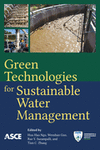Chapter 2
Rainwater Harvesting in New South Wales, Australia
Publication: Green Technologies for Sustainable Water Management
Abstract
In Australia, recent droughts and concerns about climate change have highlighted the need to manage water resources more sustainably. Rainwater harvesting has emerged as a new field of sustainable water management, which offers an alternative water supply for at least nonpotable uses. This chapter illustrates a detailed sampling on the concentration of pollutants in metropolitan rainwater tanks located at different parts of Sydney. Some rainwater tanks incorporate simple sand filtration devices to improve water quality for potable uses. Concentrated pollutants remaining after treatment and sludge can be discharged to the sewer, alleviating sludge disposal problems, and is attractive in creating a low maintenance system. It is possible to create a sustainable development with a low demand for town water and low storm water pollution export, as well as reduce storm water discharges. Some of the rainwater treatment technologies discussed include adsorption, pilot scale application, and membrane filtration.
Get full access to this article
View all available purchase options and get full access to this chapter.
References
Australian Bureau of Statistics. (2007). “Environmental issues, people’s views and current practices.” Canberra.
Australian Government. (2004). Australian drinking water guidelines, National Health and Medical Research Council, Australian Water Resources Council, Australia.
Australian Government. (2004). “Guidance on use of rainwater tanks.” Australian Government Dept. of Health and Ageing, Canberra.
Eaton, A., Clesceri, L., Rice, E., and Greenberg, A. (2005). Standard methods for the examination of water & wastewater, 21st Ed., American Public Health Association, American Water Works Association, Water Environment Federation.
Edwards, M., Hidmi, L., and Gladwell, D. (2002). “Phosphate inhibition of soluble copper corrosion by-product release.” Corros. Sci., 44(5), 1057–1071.
Kus, B., et al. (2012a). “Performance of granular medium filtration and membrane filtration in treating storm water for harvesting and reuse.” Desalin. Water Treat., 45(1–3), 120–127.
Kus, B., et al. (2012b). “Two stage filtration for stormwater treatment: A pilot scale study.” Desalin. Water Treat., 45(1–3), 361–369.
Kus, B., Kandasamy, J., Vigneswaran, S., and Shon, H. K. (2010a). “Water quality characterisation of rainwater in tanks at different times and locations.” Water Sci. Technol., 61(2), 429–439.
Kus, B., Kandasamy, J., Vigneswaran, S., and Shon, H. K. (2010b). “Analysis of first flush to improve the water quality in rainwater tanks.” Water Sci. Technol., 61(2), 421–428.
Kus, B., Kandasamy, J., Vigneswaran, S., Shon, H. K., and Moody, G. (2013a). “Household rainwater harvesting system–Pilot scale gravity driven membrane-based filtration system.” Water Sci. Technol. Water Supply, 13 (3), 790–797.
Kus, B., Kandasamy, J., Vigneswaran, S., Shon, H. K., and Moody, G. (2013b). “Gravity driven membrane filtration system to improve the water quality in rainwater tanks.” Water Sci. Technol. Water Supply, 13(2), 479–485.
Kus, B., Kandasamy, J., Vigneswaran, S., and Shon, H. (2011). “Water quality in rainwater tanks in rural and metropolitan areas of New South Wales, Australia.” J. Water Sustainability, 1(1), 33–43.
Li, S., Ni, L., Sun, C., and Wang, L. (2004). “Influence of organic matter on orthophosphate corrosion inhibition for copper pipe in soft water.” Corros. Sci., 46(1), 137–145.
Magyar, M. I., Mitchell, V. G, Ladson, A. R., and Diaper, C. (2007). “An investigation of rainwater tanks quality and sediment dynamics.” Water Sci. Technol., 56(9), 21–28.
Magyar, M. I., Mitchell, V. G, Ladson, A. R, and Diaper, C. (2008). “Lead and other heavy metals common contaminants of rainwater tanks in Melbourne.” Water Down Under 2008, Adelaide, Australia, 409–417.
Shon, H. K., Kim, S. H., Erdei, L., and Vigneswaran, S. (2006). “Analytical methods of size distribution for organic matter in water and wastewater.” Korean J. Chem. Eng., 23(4), 581–591.
Information & Authors
Information
Published In
Copyright
© 2016 American Society of Civil Engineers.
History
Published online: Jul 1, 2016
ASCE Technical Topics:
Authors
Metrics & Citations
Metrics
Citations
Download citation
If you have the appropriate software installed, you can download article citation data to the citation manager of your choice. Simply select your manager software from the list below and click Download.
